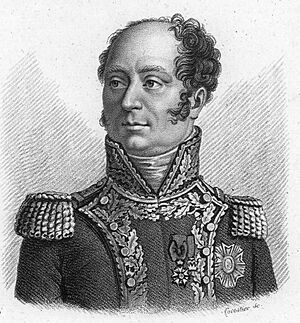Louis Baraguey d'Hilliers facts for kids
Quick facts for kids
Louis Baraguey d'Hilliers
|
|
|---|---|

19th-century depiction of Louis Baraguey d'Hilliers
|
|
| Born | 13 August 1764 Paris, France |
| Died | 6 January 1813 (aged 48) Berlin, Province of Brandenburg, Prussia |
| Allegiance | |
| Branch | |
| Rank | Général de division |
| Wars and battles | |
Louis Baraguey d'Hilliers (born August 13, 1764 – died January 6, 1813) was a French general. He fought in two big wars: the French Revolutionary Wars and the Napoleonic Wars. He was also the father of Achille Baraguey d'Hilliers, who became a very important military leader called a Marshal of France.
Contents
Early Military Career
Louis Baraguey d'Hilliers was born in Paris, France. He came from a family that had a small noble title. In 1784, he joined the French Army as a lieutenant. When the French Revolutionary Wars began, he chose to stay in France and fight for his country.
Rising Through the Ranks
By 1793, Louis Baraguey d'Hilliers had been promoted to a high rank called général de brigade. This happened during the siege of Mainz. He worked as the chief of staff for General Adam Custine. A chief of staff helps a general plan and manage their army. When General Custine was arrested, Baraguey d'Hilliers was also taken into custody. Luckily, he was released after a major political change in France.
In 1796, Baraguey d'Hilliers was in charge of part of Paris. His job was to protect the city from rebels. After a short time in prison, he was sent to serve in Louis Hoche's army. Later, he moved to Italy and worked under Napoléon Bonaparte. He became the governor of Lombardy, a region in Italy. He helped capture the city of Bergamo. He also led a group of soldiers called a brigade at the Battle of Rivoli. In 1797, he was promoted again to général de division, an even higher rank. After this, he became the governor of Venice.
Adventures Abroad
In 1798, Baraguey d'Hilliers went with Napoleon to Egypt. After the French took Malta, he was sent back to France. He was carrying important items captured during the war. However, on his way back, his ship was stopped by the British Royal Navy. He became a prisoner of war. After he was released, he faced a military trial but was found innocent. He then joined General Jacques MacDonald as his chief of staff. In 1800, he fought in the Battle of Stockach and the Battle of Biberach. Later, he was given the job of guarding the Valtellina region.
Napoleonic Wars
In 1801, Baraguey d'Hilliers became the Inspector General of infantry. This meant he was in charge of checking and improving the foot soldiers. In 1804, he became a colonel general of the dragoons, who were soldiers who rode horses and also fought on foot.
Key Battles and Roles
During the 1805 military campaign, he commanded a division of dragoons. He fought under Marshal Michel Ney at the Battle of Elchingen. In 1808, he became the governor of Venice again.
In 1809, Baraguey d'Hilliers served under Viceroy Eugène de Beauharnais. A viceroy is someone who rules a country or province as the representative of a king or queen. At the Battle of Piave River, he led a large group of soldiers called a corps. He also showed great bravery at the Battle of Raab, where he led one of his divisions. After these battles, he was sent to be the governor of the County of Tyrol. His mission was to bring peace to the region.
Final Campaign and Death
In 1810, he was sent to Spain and served in Catalonia. He was later called back from Spain to join the Russian campaign in 1812. His troops were ordered to guard Smolensk after the French captured the city. During the difficult retreat from Moscow, Emperor Napoleon ordered Baraguey d'Hilliers to meet him. However, his division accidentally marched into the path of the Russian army. The Russians surrounded one of his brigades, forcing them to surrender on November 9. Because of this incident, Emperor Napoleon was very displeased with him. Louis Baraguey d'Hilliers died in January 1813 in Berlin.

